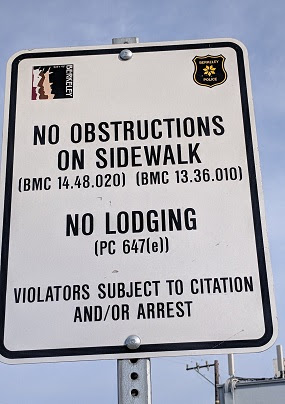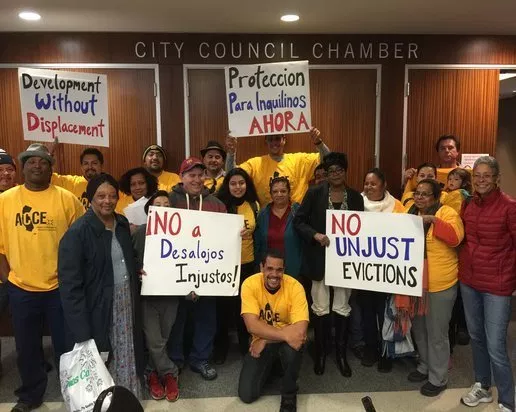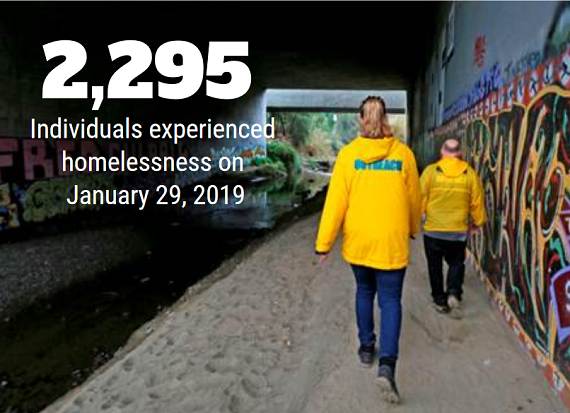Victory for No Coal in Richmond: How It Happened
The scrappy industrial city of Richmond took a bold step toward a fossil fuel-free future on Tuesday night when its city council passed an historic land use ordinance banning the storage and handling of coal and petroleum coke in a three-year phaseout.
This means that Richmond will no longer be the source of one-fourth of West Coast coal exports to Asian markets, and its children will be able to breathe a little easier.
Councilmember Eduardo Martinez, the sponsor of the ordinance, set a shining example in his refusal to back down and his unwavering belief that the city of Richmond deserves far better than coal and refining dregs.
11-15-2019: Deadline for EBRPD endorsement applications
Safe Humane RV Parks
As the Bay Area struggles with a crisis in affordable housing, there has been a spike in people living in vehicles, including recreational vehicles (RVs). As RVs crop up, East Bay cities are looking at various ways to accommodate – or discourage – them.
For example, in June, Mountain View voted to enact several restrictions on motor homes and RVs, including effectively banning overnight parking (from 2-6am) on large motor homes and trailers. Similarly, Palo Alto is requiring people move vehicles on public roads every three days.

Then a few months ago, Berkeley sent shockwaves through the East Bay when it voted to pass an ordinance banning the overnight street parking of RVs, a move that would affect the 200 or so RVs in the city. Facing public outcry, and concern from neighboring Oakland, the city agreed to delay implementation of the ordinance. Now Berkeley is considering allowing a limited number of RVs to stay under a new permitting process, which would prioritize those with special needs, among others. The city has also approached the school district to inquire whether school lots can accommodate RVs for those with children attending schools in Berkeley.
Oakland, in contrast, opened the Bay Area’s first safe parking location for RVs last month as part of a new pilot program. The lot, near the Coliseum, includes security, a site manager, and portable toilets and wash stations. There is plan to bring in mobile shower trucks every week. The site, which will cost $600,000 per year to maintain, is the first of several that the city is considering. The program will allow RVs to park for six months, with the goal of getting people into permanent housing. Not everyone will qualify for the program, however; its is invitation-only for Oakland residents, and people who live in inoperable RVs and those with children under 18 will not qualify.
A similar plan may come to Richmond as well. In October 2018, Richmond Councilmember Melvin Willis introduced an item to instruct the City to study the feasibility of establishing an RV park to accommodate the increasing number of unhoused people living in vehicles. The study has been completed and should be released shortly. The establishment of such a safe and humane RV park in Richmond is one of the priorities of the Richmond Progressive Alliance’s Housing Action Team. According to Daniel Barth (see interview below) such as park "would provide a place to safely park and establish a stable community for the most secure of the city's unsheltered population, which means people living in RVs with their amenities."
Preventing Evictions = Preventing Homelessness

Many experts believe that one of the most cost-effective ways to prevent homelessness is by preventing evictions.
One tactic for preventing evictions is through emergency grants. East Bay cities, counties and non-profits (such as Catholic Charities of the East Bay) offer eviction prevention funds, some of which are supported by federal Housing and Urban Development grants. Eviction prevention funds may be dedicated to particular populations, such as veterans, single moms with children or disabled people facing the loss of housing. Others are more general and can assist families who are falling behind on their rent. For example, a family may experience a health crisis or the death of a family breadwinner, and face a landlord who does not hesitate to begin eviction proceedings. A grant of a few thousand dollars – perhaps in combination with legal assistance from groups like Bay Area Legal Aid -- can serve as a critical safety net and make difference between housing stability and being out on the street.
Other ways to prevent evictions is through strengthening tenant rights and public policy. In Richmond, Measure L – the rent control and Just Cause for evictions ordinance – has helped keep people in their homes. (It has never been a solution to the lack of affordable housing, as opponents have falsely argued.) But on the state level, these anti-displacement measures have struggled to take hold. A state-wide rent control and just eviction ballot measure failed in 2016 after an intense $80 million lobbying campaign by landlords.
But recently, AB 1482, sponsored by Assemblyman David Chiu (San Francisco) has gained momentum and is advancing to the Senate. “We have millions of Californians that are one rent increase away from being forced out of their homes for decades,” Chiu said in a Los Angeles Times article. “They are our neighbors. They are our co-workers. They are our brothers and sisters. They are our grandmothers.”
Chiu’s bill would limit rent increases to a maximum of the consumer price index plus 7% per year. The bill had originally included a lower rate, but it was raised after push-back from real estate and landlord lobby. It would also only apply to units constructed more than ten year ago, and would phase out after three years. Finally, the legislation has some anti-eviction measures but they are weak compared to those in a companion bill, AB 1481, which stalled this session. Although some housing advocates are not happy with Chiu’s (now watered-down) bill, they are encouraged that some progress is being made.
Resources for People Facing Homelessness

Know of someone facing homelessness? Contra Costa County’s Coordinated Outreach Referral, Engagement (C.O.R.E.) program works to engage and stabilize homeless individuals living outside through consistent outreach to facilitate and/or deliver health and basic need services and secure permanent housing.
C.O.R.E. teams serve as an entry point into Contra Costa’s coordinated entry system for unsheltered persons and work to locate, engage, stabilize and house chronically homeless individuals and families. The outreach teams identify individuals living on the streets, assess their housing and service needs, and facilitate connection to shelter and services.
To notify a C.O.R.E. team about an unsheltered homeless individual or family, please call 211. Please note that C.O.R.E. teams are not designed for crisis response. For medical or other emergencies involving homeless individuals, please call 911.
People facing eviction can contact Bay Area Legal Aid, which provides legal help to low-income individuals.
Responding to the Homelessness Crisis

[Graphic: 2019 CCC homeless point in time count.]
The numbers are in, and it's not pretty: homelessness in CCC increased by a shocking 43 percent in the last two years – one of the tragic byproducts of recent skyrocketing rents.
Emergency shelters are one response of course, but there are not nearly enough beds in Contra Costa to fill the need, especially for single adults. A lack of beds means that more people are sleeping on the streets, in cars and in tent encampments. Neil Donovan of the National Coalition for the Homeless calls encampments “America’s de facto waiting room for affordable housing” and notes that “Living in a tent says little about the decisions made by those who dwell within and more about our inability to adequately respond to fellow residents in need.”

[Photo: Oakland Housing and Dignity Village, 2018]
Encampments can range from the unorganized and informal to the very intentional. They can be organized by charities, government or residents. Safe, humane RV parks as a transitional solution (article below) describes how Oakland is creating an RV encampment to get people into transitional housing. This is an example of a sanctioned encampment, but many are unsanctioned and therefore potentially illegal. An OpEd by Anita De Asis Miralle, Criminalizing the homeless should not be the solution (below) describes the clashes that can occur when a self-organized, family-oriented – but unsanctioned -- encampment forms.
Daniel Barth of SOS! Richmond argues in favor of government-sanctioned encampments, but ones that are organized, managed and governed by residents in partnership with charities and faith groups. By permitting these encampments, it can increase safety, stability, social cohesion and correct public negative perceptions. Barth stresses that this last element is critical, because “The #1 need for change is our own willingness to see homeless interventions happen in our own neighborhoods – not across town.”
Homelessness in CCC Up 43 Percent in 2 Years
Homelessness in Contra Costa increased by 43 percent in the last few years, according to the county’s latest homeless point in time count conducted in January. Several nearby counties also reported significant increases in homelessness, a dire sign of the Bay Area's crisis of affordable housing and displacement. The data show that approximately 60 percent of unsheltered people in Contra Costa sleep on the streets, while about 30 percent sleep in cars. Only three percent sleep in warming centers, which are short-term, temporary shelters that operate during winter months.
About 2,000 people lack housing on any given night in the county (the point in time count, conducted in late January, estimated the homeless population to be 2295 people), and waiting lists for shelters are often long. The study showed that while around 68 percent of homeless families can be served by available shelters, only 28 percent of homeless single adults can access shelter beds.
In a KQED interview, Jaime Jenett, a planning manager with Contra Costa Health Services, directly spoke to the problem of skyrocketing rents and stagnant wages for lower income people. "They need affordable housing that is really targeted to low- and very low-income folks," she said. "A lot of the quote-unquote affordable housing is just completely out of reach for the people that we're working with."
While the majority of homeless people are between 25-54 years old, Jenett noted that there is a disturbing increase in the number of older adults without homes.
City Council Endorsement Applications
If you're thinking about running for Richmond City Council and would like an endorsement from the RPA, the time to act is now!
Read about the process and download the questionniare. Your answers must be submitted by September 1, 2019. Interviews will take place in September. The final decision about endorsements rests with a vote of RPA members.
Conversation with Homelessness Advocate Daniel Barth
The Activist sat down with Daniel Barth of SOS! Richmond (Safe Open Spaces) to talk about how to tackle homelessness in Richmond. Daniel has been a longtime advocate to reduce and end homelessness both in Alameda and Contra Costa. SOS! Richmond works as an important partner with the Richmond Progressive Alliance’s Housing Action Team.
 TA: Homelessness has been a problem for decades. What in your view are some of the drivers?
TA: Homelessness has been a problem for decades. What in your view are some of the drivers?
DB: Our communities have for decades seen a lack of community-based support for treatment of mental illness. In the 80’s, crack and AIDS ravaged families. No surprise that intergenerational homelessness exploded during the 90’s. Yet our safety net shrunk as shelters, treatment centers, and transitional housing were shuttered. The federal agenda has been a major driver for increasing homelessness, with decreased spending and losses of public housing. We all know how rental prices continue to rise, resulting in more rent-burdened renters, while homeownership has declined for lower income earners, since higher wages for some households, results in further pressure on rental markets for lower wages earners and those on fixed incomes. What happens? There’s simply not enough access to housing, supportive services, opportunities for making personal change, and emergency interventions to address homelessness.
TA: What are some of the most significant new developments you are seeing these days?
DB: One of the biggest new trends is the aging of the existing homeless population, in parallel with the aging of the general population. More seniors are also falling into homelessness due to the increasing cost of living in the Bay Area – more than half are 50 years of age or older, and yet the average life span for a homeless person living on the streets is 64 years. When we talk with people who are sleeping along freeways, train tracks, and at any edge of our neighborhoods they can stay at, we know that more than 1/3 have been homeless for 5 years or longer, and yet more than 1/3 have been Richmond residents for 20 years plus.
TA: What ultimately needs to change?
DB: The #1 need for change is our own willingness to see homeless interventions happen in our own neighborhoods – not across town. Only then can we enable new opportunities for folks to participate in that are low-cost (to scale-up), encourage self-determination (people “owning” their own changing), and are community-integrated (building partnerships between housed and unhoused neighbors).
The struggle to create Safe, Organized Spaces starts with us. Only through community-integrated approaches can we see improved health & safety in people’s living arrangements; the stability required to address unemployment and other issues; a secure place to store belongings and medications while looking for work; improved quality of life and ability to increase income; a sense of dignity and hope; the focus of having a purpose in a community living environment and the ability to serve others in the benefit of community goals. We all need the same things in life.
TA: What should be done in the immediate, short term?
DB: We can’t wait for housing and services to materialize for unsheltered homeless people in Richmond. We need interim sheltering interventions. What does this look like? These are temporary, transitional "villages". Many successful transitional villages have been sustained in other cities around the country, which have enabled people to stabilize their lives and ultimately find work and housing. A village consists of a number of small sleeping structures on a single lot – either tiny houses similar to the ones used in Seattle, WA, or Conestoga huts like those used in Eugene, OR. These “emergency sleeping cabins” will meet all of the codes required for emergency shelters.
Responsible individuals who truly want to change their lives are selected to live in these intentional communities, in which residents cooperate and share duties. These are safe and visually attractive, and a primary goal will be to have a positive impact on the neighborhood. A clearly defined set of rules are enforced and staff and “Safety Guardians” are present at all times.
TA: SOS! Richmond is working with the RPA’s Housing Action Team on homelessness. What are other things we can do here?
DB: In a Richmond where we stabilize our growing crisis of homelessness, we can then take responsibility for access to housing. One model is to provide affordable, integrated, and well-maintained Municipal Housing. Local governments like ours, supported by the federal government, must build a very large amount of affordable, mixed income, publicly-owned housing, initially by developing existing publicly-owned land. We must stand up for having resources come to West County. We start by developing safety nets of "pocket villages" in our own neighborhoods.
Pt. Molate Subsequent Environmental Impact Report scoping session 7/29/19
The proposed project is now 2200 residential units. This was never voted on by the council and thus is not a legal alternative.
Moreover, this is a significantly different project from the Casino alternative and all other alternatives in the old EIS/EIR. A full new EIR needs to be prepared for evaluation and comment.
EIS/EIR was approved over a decade ago. Circumstances have changed significantly, especially traffic conditions and climate change impacts. Even if the information in the old EIS/EIR was valid at the time of that document, with the length of time and major changes in conditions, the city must start from scratch and do a full new analysis since the old EIS/EIR is no longer relevant
It also inconsistent with the General Plan that designates the Pt Molate area as open space to protect environmental values.
The proposed project is contrary to the Plan Bay Area policies for regional development. Adopted in 2013, Plan Bay Area is our first regional plan to incorporate a state-mandated Sustainable Communities Strategy. It identified Preferred Development Areas or PDAs close to public transit, existing commercial and retail uses so as to reduce auto traffic and emissions. Pt Molate is not one of Richmond’s five PDAs. The City will need to evaluate how it can comply with Plan Bay Area policies and the impacts for failing to do so.
The City needs to evaluate the recently released Hatch fiscal impact report and explain how the City can approve any project that could result in the city losing $3.00+ million in revenue from the proposed development.
